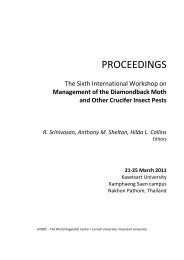Leguminous Vegetable Cultivation and Seed Production S ...
Leguminous Vegetable Cultivation and Seed Production S ...
Leguminous Vegetable Cultivation and Seed Production S ...
You also want an ePaper? Increase the reach of your titles
YUMPU automatically turns print PDFs into web optimized ePapers that Google loves.
Basal fertilizer application: Have soil samples analyzed. The fertilizer requirements are<br />
determined on the basis of the soil test. The higher the soil nutrient level, the lesser will be the<br />
quantity of fertilizer needed. To get a good harvest (7-10 tons green pods per hectare) <strong>and</strong><br />
maintain soil nutrient status for consistent productivity, a fertilizer mix containing N, P205 <strong>and</strong><br />
K20 at the rate of 20-30, 60 <strong>and</strong> 80 kg/ha respectively is applied by broadcast as a basal dose<br />
<strong>and</strong> incorporated into the soil with final harrowing <strong>and</strong> leveling of the field.<br />
Use of Rhizobium inoculation: Usually Rhizobium inoculation is not required in fields<br />
where legumes are cultivated. But newly opened l<strong>and</strong>s need Rhizobium bacteria inoculations at<br />
10 g per kilogram of seed. The use of Rhizobium bacteria culture will promote nodule formation<br />
<strong>and</strong> nitrogen fixation by the plant roots.<br />
<strong>Seed</strong>bed preparation: The soil should not be too dry at the time of seed bed preparation.<br />
Inadequate moisture will result in poor seed germination. At AVRDC, we irrigate the field 3-4<br />
days prior to sowing to ensure sufficient moisture in the soil for good germination of seed.<br />
Prepare 20-cm raised beds spaced one meter apart from center of one bed to the center of the<br />
next.<br />
<strong>Seed</strong> treatment <strong>and</strong> planting: The seed is' treated with protectant fungicides such as captan or<br />
thiram at 3 g a.i./kg seed for protection against soilborne fungal diseases. Spacing between rows<br />
is 45 cm <strong>and</strong> between plants 5-10 cm depending upon seed size <strong>and</strong> season. Two to three seeds<br />
are sown in each hill. However, spacing between rows varies with variety <strong>and</strong> season. Usually<br />
seeding (60 to 80 kg seed/ha) is regulated to obtain a population of 400,000 plants per hectare.<br />
Sow seeds by h<strong>and</strong> or by, a h<strong>and</strong> operated planter.<br />
Top dressing of fertilizer: The first top dressing is done at the rate of 20 kg N + 25 kg K20<br />
per hectare along plant rows at flowering for higher pod set. A second application of 20 kg N per<br />
hectare is done at the beginning of pod filling stage to improve seed size.<br />
Weed controlt At AVRDC, application of alachlor at 1.5 kg a.i./ha either alone or combined<br />
with pendimethalin at 0.75 kg a.i./ha as pre-emergence spray is practiced to control weeds.<br />
Intertillage: Intertillage once or twice is beneficial for aeration of root system <strong>and</strong> to control<br />
weeds which emerge after the effect of chemical weedicides fades off.<br />
Irrigation: Maintaining proper soil moisture throughout the crop growing season is important<br />
for good quality pods. Usually, first irrigation is needed within a week after sowing under<br />
AVRDC soil conditions. Irrigation is done in furrows. Depending upon weather <strong>and</strong> soil<br />
moisture conditions, the irrigation is continued at 10-15-day intervals until the pods are well<br />
developed. However, irrigating the crop is essential at critical periods such as flowering <strong>and</strong> pod<br />
filling stages.<br />
Disease control: Rust may be a serious problem, especially for seed production, causing up to<br />
100% yield loss. Tan, dark brown or reddish brown lesions occur on leaves of rust-affected<br />
plants. None of the commercial cultivars are resistant to rust, but rust-tolerant breeding lines have<br />
been selected at AVRDC. Fungicides such as mancozeb or triadimefon at the rate of 2 kg a.i./ha<br />
are sprayed at 10-day intervals to control rust in susceptible cultivars.<br />
Downy mildew disease commonly occurs during spring <strong>and</strong> autumn seasons but it does not<br />
generally cause yield reduction. The symptoms are pale green to light yellow spots on the surface<br />
of the leaf. These spots later enlarge into pale to bright yellow lesions. The underside of the leaf<br />
shows white powdery spores. To control downy mildew, plant resistant cultivars. For<br />
susceptible cultivars spray fungicides such as mancozeb at the rate of 2 kg a.i./ha depending<br />
upon severity of disease attack.<br />
2
















